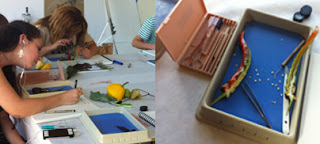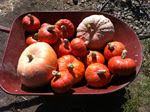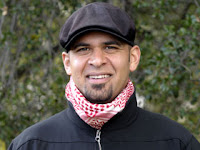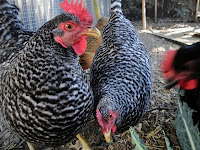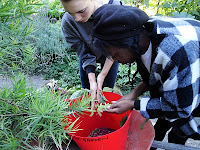OS28 Biking Co-Curricular lead by Patrick Foy, Sculpture teacher with assistance from Holly McVeigh, Admissions Director.
Co-Taught Observation Project
10/03/12
Oxbow's first project addressed the theme of Observation. The unit was team taught by art and humanities faculty pairs. In the class led by Environmental Science teacher Lenora Ditzler and Painting teacher Chris Thorson, students observed the Oxbow gardens through the lenses of artist and scientist. Students discussed the biotic and abiotic aspects within an ecosystem, studied form and function through dissection, and translated their observations through finished works in charcoal and acrylic paint. In the assignments’ final days, students developed paintings from a botanical still life.
Garden Field Trip
09/30/12
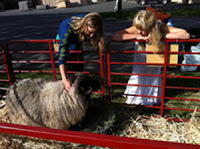 Painting teacher Chris Thorson with Miranda on a garden co-curricular field trip to the The National Heirloom Exposition.
Painting teacher Chris Thorson with Miranda on a garden co-curricular field trip to the The National Heirloom Exposition.
S27+2.jpg) |
| Natalie and Jeana |
I grew up in Portland, Oregon and attended Oxbow in the Fall of my senior year of high school. I felt that my perspectives on school, personal relationships, and life in general were so changed by my experience at Oxbow that I promised myself I would return to work there. After high school, I went on to attend the Maryland Institute College of Art. This May, I graduated with a BFA in textile, garment and costume design. In my work I create wearable art, costumes and jewelry from old clothing, fabric scraps and polymer clay. I am currently working on a small clothing line and selling jewelry through my etsy shop. My hope is that by coming back I will help the next generation of Oxbow students thrive in their time here. To view my work, please visit www.natalie-ebaugh.com.
 |
| Didier William with Max Byck |
Didier is working with students on Cambiaso and Planar studies with the figure. Students work from a live model and translate organic form into rectilinear planar studies in order to better understand the density of the human figure, angling, precise measurement, torque and direction.
One projects is to create a composition that includes at minimum 20 hands and 20 feet. The composition must create a narrative, students are asked to think both creatively and conceptually about the ways in which transformation, context, and composition can dramatically affect the narrative. Students also use powdered graphite and rags to draw focusing primarily on tone, density, and basic shape. Drawing with powdered graphite and paper towels forces student to not only see the ways in which abstract shape and value creates total form, but also forces them to be much more inventive with the actual marks used to describe the form.
For their self-portrait project students are asked to make 30 drawing of themselves in sequences of 5, 6 sequences total. Each drawing will be fully considered, both object (the face) and background and should take no more than 45 minutes to complete. In fact, as the project evolves the drawings will naturally take less and less time to realize. The primary goal in this exercise is to allow students to develop a sensitivity to the material by keeping then subject consistent.
Towards the end of the residency Didier will meet with students in studios for 15 minute sessions to discuss individual progress and then in the final days conduct a group critique with student's work.
Didier William holds an MFA in painting from Yale University, and a BFA in painting from the Maryland Institute College of Art (MICA). He currently lives and works in Brooklyn, NY. Originally from Port-au-prince he was a 2009 recipient of the Toby Devan Lewis Fellowship in painting as well as the 2006 recipient of the Morris Lewis Award for painting. He has exhibited paintings in group shows at Kravets Wehby gallery in New York, Deitch Projects in Long Island City, Swann Galeries in New York City, Gallerie Schuster in Berlin, as well as traveling exhibitions in Baltimore, Kansas City, Philadelphia, and Greece. He is currently on the faculty in the Art/Art History Department at Vassar College in Poughkeepsie, New York.
 |
| Nora & Jeana our current Oxbow Interns |
Originally from Pennsylvania, I recently graduated from Columbia University in New York City. As a visual arts major, I worked mainly in printmaking and book arts. In my senior year, I also had the opportunity to teach an introductory art class at a public school in the city. This, along with other tutoring and volunteer positions, helped me to channel my passion for working with youth, to hone my skills and learn a whole host of new ones to help better myself as an educator. After graduation, I moved to Ghana, West Africa as a recipient of a traveling fellowship for young artists. I spent my time researching the rich cultural commerce surrounding their celebratory death rituals and writing about my experiences.
After spending four months in Ghana, moving to Napa was a big transition, to say the least. Upon my arrival at Oxbow, I felt the energy of the school running through me like a current. Just a month into my time here, every day is a new adventure.
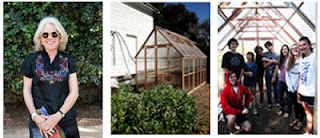 |
| Katie Wheeler, the Greenhouse and the OS26"Green Team" |
The seedlings have moved out of the studios and into their new home.
The Oxbow Greenhouse is now a reality thanks to the generous funding of Oxbow Board member Katie Wheeler.
The greenhouse arrived to Oxbow in boxes and the structure was assembled by our own OS26 student Green Team!
Why is Oxbow so Cool?
09/16/11
As I enter my second full year as the History Instructor at The Oxbow School, I've been thinking quite a bit about why Oxbow is such a special place. As a veteran, or, ahem, a survivor, of the public charter school system as well as other residential programs, it's easy to reduce the glory of Oxbow to the experience of a teacher. In other words, it's a great place because, as a worker, I feel taken care of and supported in my craft as well as in the development of my skills as a facilitator of learning. In addition, I am afforded plenty of freedom to create learning experiences that I believe will optimize the learning of the participants in the program. As much as I am grateful for the opportunity to teach at Oxbow, we all know that my personal experience is simply insufficient to explain the je ne sais quoi of this wonderful place.
Upon further reflection, I realize that it is the students themselves that make this program so successful. With so many high-skilled, highly motivated and inspired learners in our midst, it is actually difficult not to have a successful class. The insatiable hunger for knowledge and art that the students express regularly pushes the educators to provide ever-expanding and ever-challenging questions that will drive student exploration.
These young people make teaching easy. Their willingness to explore deep ideas and the applications in the real world as well as in art propel the ownership of the learning from the teacher to the student. They own their own learning... almost to the point where these young minds make the act of teaching obsolete.
So what makes Oxbow so cool? My reply: “Hands down, it's the students.” After all, what better way is there to teach than to allow students to explore their interests and affinities, building upon their previously constructed knowledge to gain deeper and deeper understandings of the world they will soon inherit?
Mo Elgazzar
History Instructor
From the Oxbow Garden
09/16/11


